I left Ruesta before 7 am, even before Beli and Angela, with whom I parted cordially when leaving. The two of them were having breakfast and that is why they stayed slightly behind me. Not far from the pilgrims’ hostel, a narrow path which is the Way in this section starts to descend and it is important here to follow the direction shown by the yellow arrow.
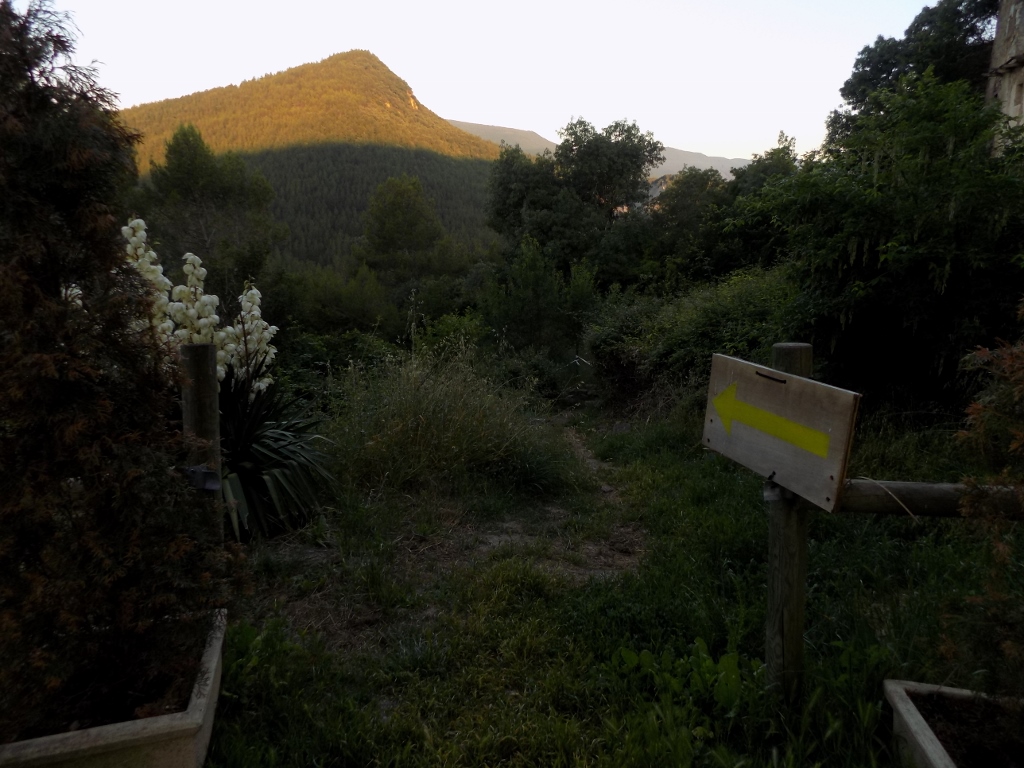 Continuation of the Way in Ruesta
Continuation of the Way in Ruesta
One needs to go down that narrow path until reaching the foot of the hill which is topped by Ruesta and then one gets to a wider dirt road. Or rather a dirt road covered by gravel. I actually don’t believe that the builders really brought gravel there, but simply there are lots of stones here. The road was nice though, but often went uphill forcing me to fight for my breath. Still, it was not too bad – it was early in the morning and the road was leading through a shade rendered by trees, while the air was often filled with the enchanting scent of the conifers. Even when I would get to a clearing, the sun was still not too strong and it was pleasant to walk. In time Angela and Beli caught up with me and surpassed me, but I preferred simply to continue following my own pace.
The Way then leaves the forested areas and goes though open spaces, which are like a plateau, leading between large grain fields. Taking into account how much rocks and stones there are along the road and how hard the ground is, I really wonder how people here provide and cultivate such large arable land areas. I suppose there are no rocks there. All the tools would break or at least get dull.
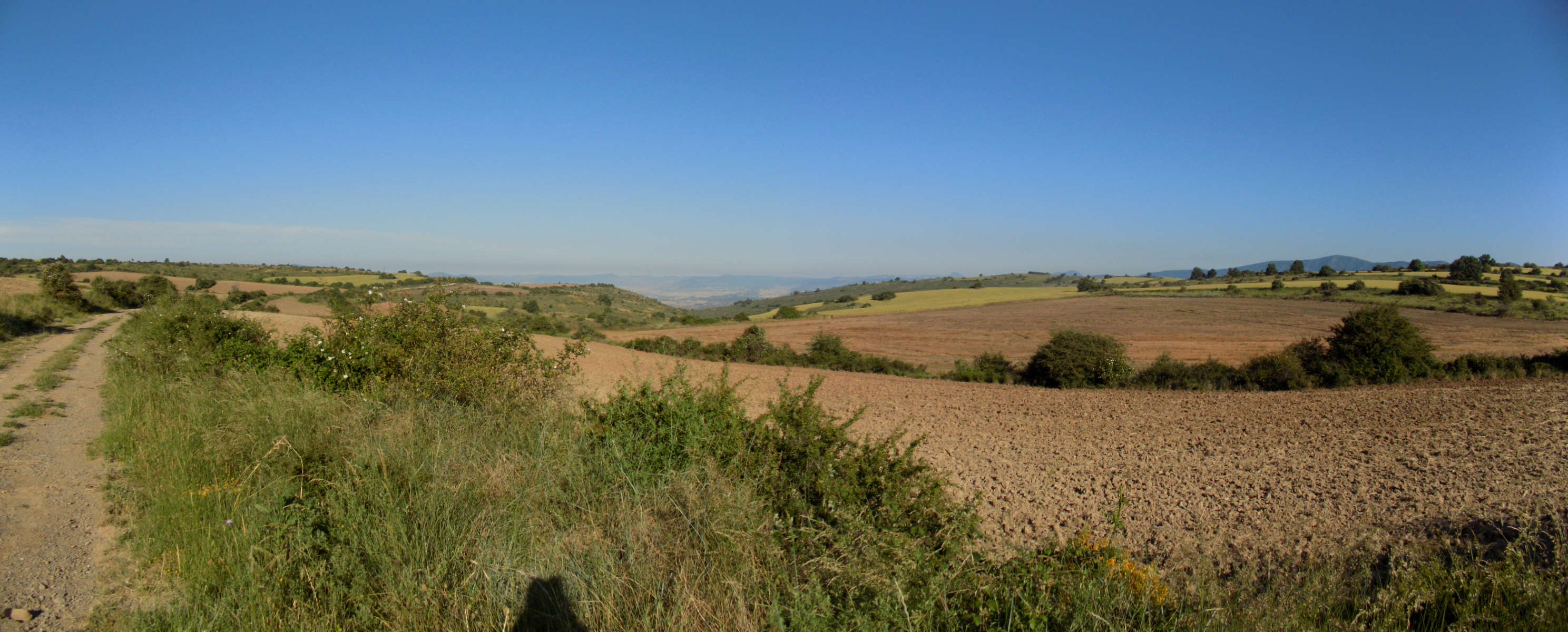
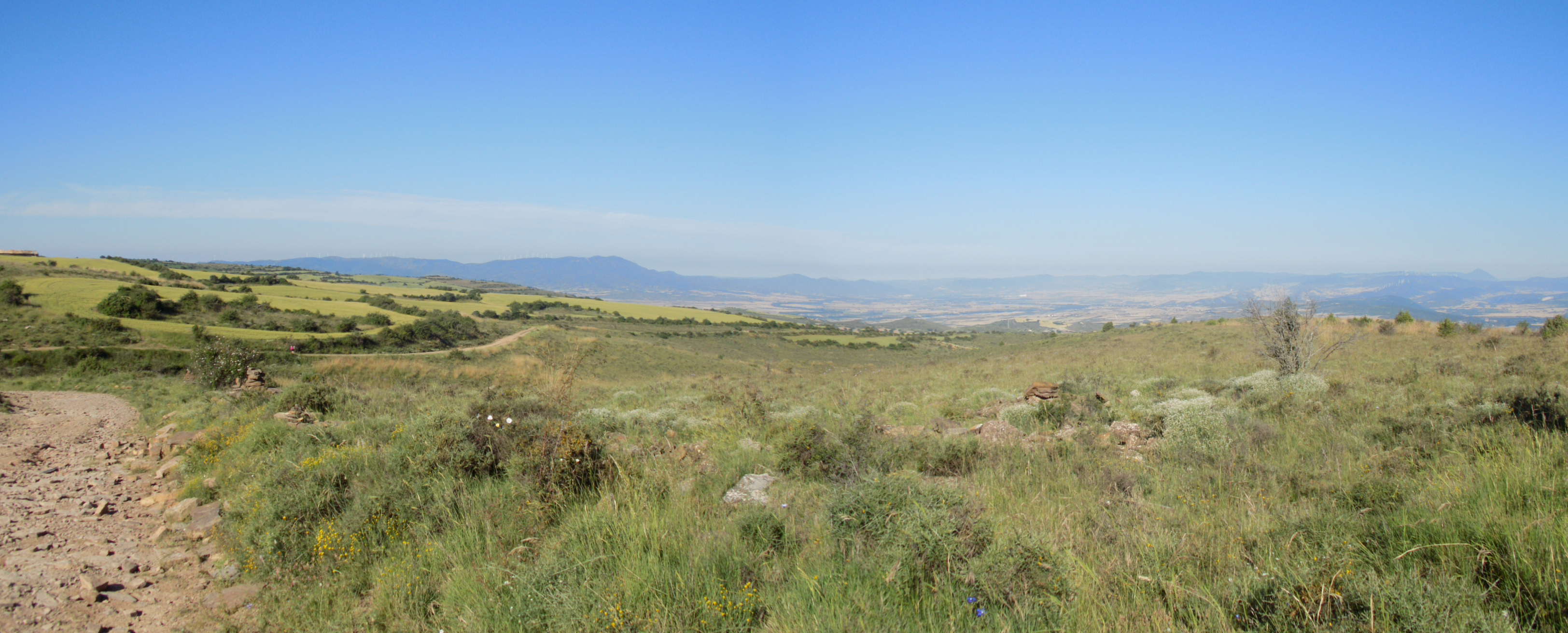
Again, I would occasionally unintentionally manage to catch up with Angela and Isabel, and soon I could spot the village of Undués de Lerda in the distance. It seemed very cute, lit by the sun and all one had to do was get down to the foot of the elevation and then go uphill a bit. Easier said than done. In that section, the Way leads over the remains of an old Roman road. These ancient Romans were true masters, not only that they made those roads of theirs some 2000 years ago and that they still endure in some form, but to pave such vast distances with large stones is an incredibly fantastic feat. However, I found it difficult to admire these achievements since with every carefully placed step, regardless of the walking technique and the exact trajectory of my walk, I constantly rammed my already painful toes against my hiking boots, so I kept seeing stars in front of my eyes even in the middle of a wonderful sunny day.
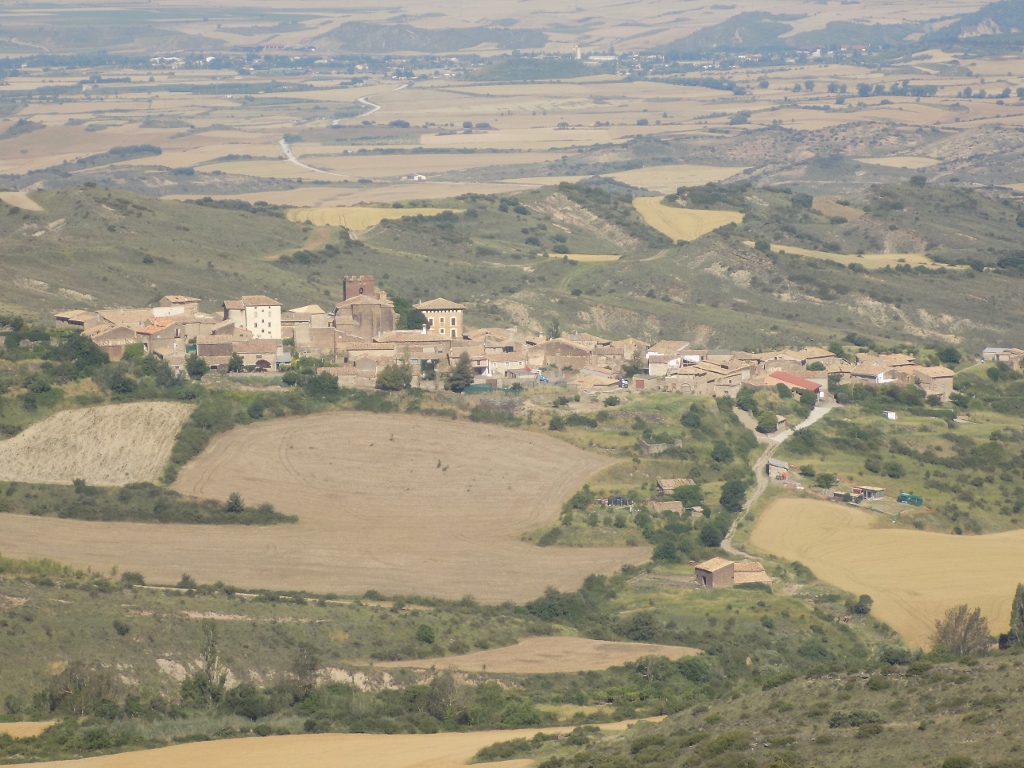 Undués de Lerda in front of me
Undués de Lerda in front of me
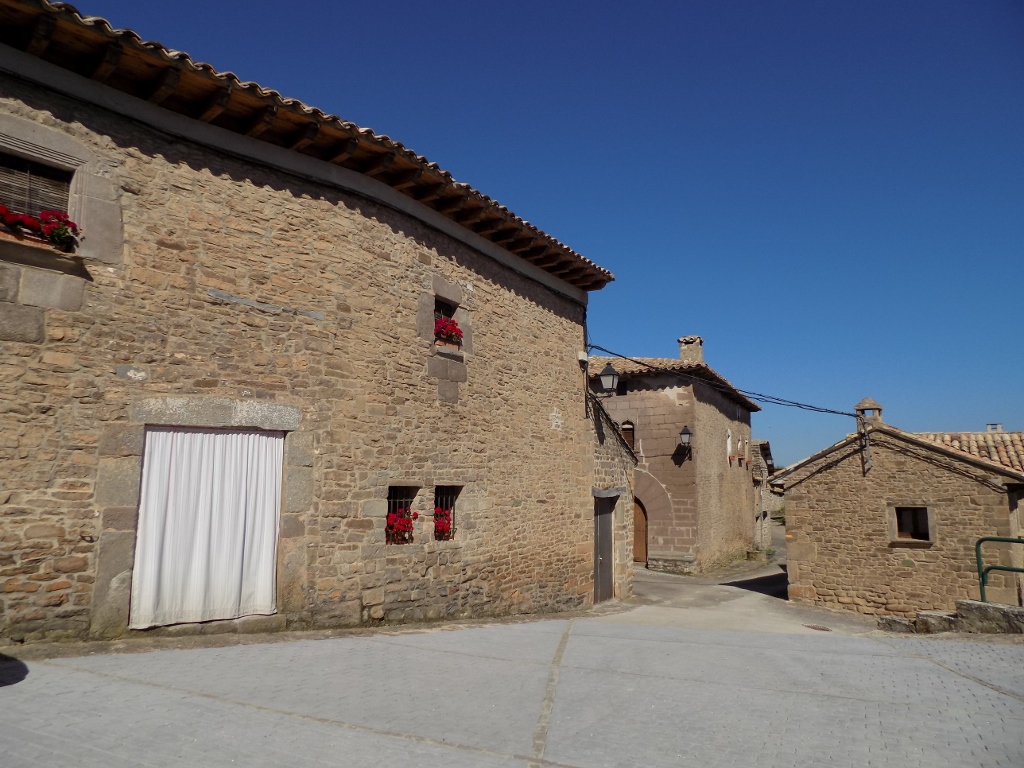 Undués de Lerda, the curtain at the entrance into the house serves to prevent flies from getting in
Undués de Lerda, the curtain at the entrance into the house serves to prevent flies from getting in
I made frequent mini-breaks, but I finally managed to get to the place and the local bar. There I found Isabel and Ulrike, so we sat together for a while and I refreshed myself with a clara, beer with soda, a rather refreshing beverage. I also ate a couple of tapas, enough to make me full and content. At some point I moved on and the Way soon turns into a rather wide road covered in gravel that leads between fields, but there were very few trees where one could find a shade and have a rest even for a short while. This is also the section where one leaves the Autonomous Community Aragon and enters the Autonomous Community Navarre.
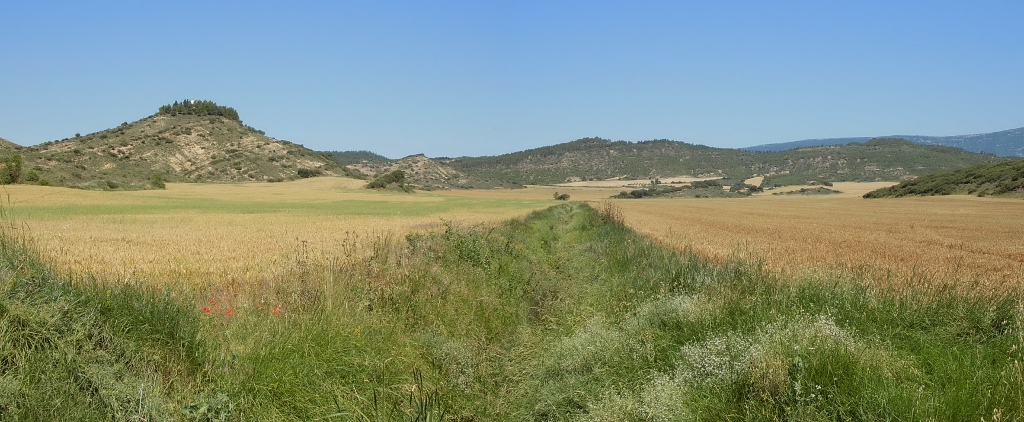 As it can be seen, there are trees here, but only on the top of a hill
As it can be seen, there are trees here, but only on the top of a hill
Also, this section was rather flat and I could go at a somewhat faster pace, although different parts of my feet kept hurting me, but I could hardly wait to reach a pilgrims’ hostel in the small town of Sangüesa. It was hot and the path seemed endless. When I eventually reached the place, I passed by a square and there in a bar I saw Piedad (the pilgrim with who I walked on the second day) who immediately jumped up to her feet and we greeted each other most cordially. She was about to continue her journey by coach as she did not feel too well and I was so tired and with such aching feet that I could not stay with her much longer and just wanted to get to the albergue.
The albergue was close, but when I got there and took my hiking boots off I almost fainted with horror. My left big toe that had turned slightly blue already the first day and a little bit more later on, that had hurt at first and later not, and that had looked bad before, was puffed up now to the point of being almost unrecognisable. The nail seemed as if any minute it would separate from the flesh and fly off since there was a blister underneath it. It was interesting though that it did not hurt when touched (admittedly gently), but what was clear to me was that I could not go any farther like this.
I started to get organised. I wrote to my insurance, but it was Saturday afternoon, so I did not know how it would all function since I had never actually used travel insurance before. In order not to waste time and wait for the answer, I decided to go to the local Health Care Centre. Luckily, Sangüesa is a town and there is something like that there. I don’t know what I would have done if this had happened to me in Arrés or Ruesta. On the other hand, since it was Saturday afternoon, I didn’t know if the Health Care Centre worked or not.
Then Francesco, a very dear and talkative Italian, like a true gentleman said he would come with me, among other reasons because my mobile phone was in roaming, while the residents of the European Union pay for each mobile call as if it were a local one, and we thought I may need the phone.
The Health Care Centre was very close to the albergue and when we got there the medical nurse on duty told me that because it was a weekend the system was such that I had to call 112, the number for emergencies. Thanks to Francesco’s phone, I called, first saying I was a foreigner and didn’t speak Spanish well, and then I explained in details what the problem was. They asked me where I was, I told them and then they said I should stay there and wait for the doctor to call me. Francesco and I waited for a short while chatting in the meantime and he was apparently mostly worried about how he would handle such a situation since he does not speak any Spanish. I tried to calm him down saying that certainly there would be somebody to help him out, just as he was helping me out.
Then it was my turn to go to the office and there was a doctor and the nurse who had told me who to call. I explained to them what the issue was, but after all they could see it for themselves. The nurse sorted out my toe, sucking out most of the liquid with a syringe, and then he squeezed it a little more in order to make sure that most of the entrapped liquid got out. Then he applied some antibiotic cream, a little bit of iodine and wrapped it all up. I watched keenly what he was doing, thus in a way getting the tricks of trade. I also mentioned to the doctor I had dry cough which appeared unexpectedly and seemed unusual since there were no flu symptoms to go with it. She did not appear surprised (probably it was something local), but listened to my lungs anyway. Everything was fine, the nurse wrote on a piece of paper what I needed to buy in a pharmacy, drew me a map and also gave me the phone number to be called announcing my arrival (again some local system). Francesco and I went there, I bought everything I needed and then we returned to the albergue where the preparations for dinner were well on their way.
Angela, the fantastic young Italian girl, had volunteered to make us all dinner, two types of Italian pasta – with tomatoes for Ulrike and Rafael, and carbonara for the rest of us. Meanwhile, I stayed for a while in bed with my feet up before the dinner taking also the opportunity to send my Facebook friends the following “report”:
Day 6: “O muerte, o fuerte!”
I’m going through magnificent landscapes. A couple of days ago, in the pilgrims’ hostel in Arrés I met for the first time a group of people (several Spaniards, a German woman, two Italians and a French man), some walk as a group, some alone, everybody at their own pace. Thus, yesterday for a while I walked together with Beli (a Spanish girl), so I was telling her how my feet keep hurting and then she said it would all be better with each passing day. I smiled saying that this was the “what doesn’t kill you makes you stronger” principle. Of course, there is a proper way to say it in Spanish, but because of the rhyme I preferred to abbreviate it into – “O muerte, o fuerte!” which could loosely be translated into: Either death or I’ll get stronger.
And so, we all on the Way walk, make breaks when and for how long we prefer, but as it turns out later in the day we all gather at the same pilgrims’ hostel where we then chat and have dinner together. Today Angela (a young Italian who loves to cook) volunteered to make us all dinner – two types of pasta, while the “guys” would get wine and sangria. We also all got our laundry in order to wash it all together in a washing machine.
Sounds fun and attractive, almost romantic, doesn’t it?
This is only because you cannot see my left toe. As it turned out that huge blister from the beginning of the journey was a small baby in comparison to this. The nail was first dark blue (ever since the first day, but I haven’t mentioned it so far in order not to seem a weakling). Then it continued to be blue and it hurt. Then it stopped hurting, but seemed as if wanting to separate from the rest of the body. Today, when I got to Sangüesa (luckily this is a town), I could see that it was all puffed up. No matter how much I love to take photos, I really did not want to take a picture of this horror, but it was clear to me that the situation called for absolutely extraordinary measures. I had to see a doctor. So, fortunately, Sangüesa is a small town and there is a health care centre, quite near to the pilgrims’ hostel, but it is a Saturday afternoon. Francesco, a very kind 73-year-old Italian, offered to come with me. Among other reasons because it was necessary from time to time to make a phone call and my mobile was in roaming. Even before going to the doctor’s he left me his phone “in case I needed it” while he went shopping for food with Angela. As Blanche DuBois would say: “I have always depended on the kindness of strangers.”
So, the two of us got to the Health Care Centre and to cut the long story short, they tended to my toe, even saying that my nail would not fall off and that this was indeed a lesser problem that the huge blister I had which in the meantime started to mend, and that I could continue with my walking the following day!!! Then I went to a pharmacy, together with Francesco who kept worrying about how he would handle a situation like this since he spoke no Spanish and there I bought everything I may need for the toe.
As a dear friend of mine has put it: “Enjoy the crap you’ve put yourself into!”
Still, I’m not sure I am going to walk tomorrow. After all, I am a reasonably careful middle-aged woman. Tomorrow’s stage is rather long, 29 km, the weather forecast says it’s going to be even hotter and finally two Spaniards have told me these days: “The Way is covered by the head, not by the feet.”
In front of me: 762 km
Behind me: 105 km
Following some rest, I joined Beli who invited me to go to a nearby primary school where there was a celebration of the end of the school year. There was a band playing, the parents and families stood around and listened to the concert or they talked amongst themselves, while some other children played. Afterwards some local music started to play, and the adults and children started to dance. Here, have a look:
Also, there was an improvised bar in the schoolyard where Beli and I bought draught beer. Then, with glasses in our hands we walked back slowly to the hostel. Right on time for the dinner. Although one of the youngest in the group, Angela proved herself to be an excellent cook. The evening was very joyful and fun, but at some point we all had to go to our beds. Tomorrow was yet another very early start.
That following day, I remained in Sangüesa and spent it rather calmly. I did walk a little on a couple of occasions, first to go back to the health care centre to have my again mildly puffed-up toe checked and then in order to see where to catch a coach a little later. Since the first information about this latter topic I got on the internet were absolutely erroneous, I also went to the tourist information office and thus I had a short walk around the centre of Sangüesa which is in fact a very nice place absolutely worth a visit.
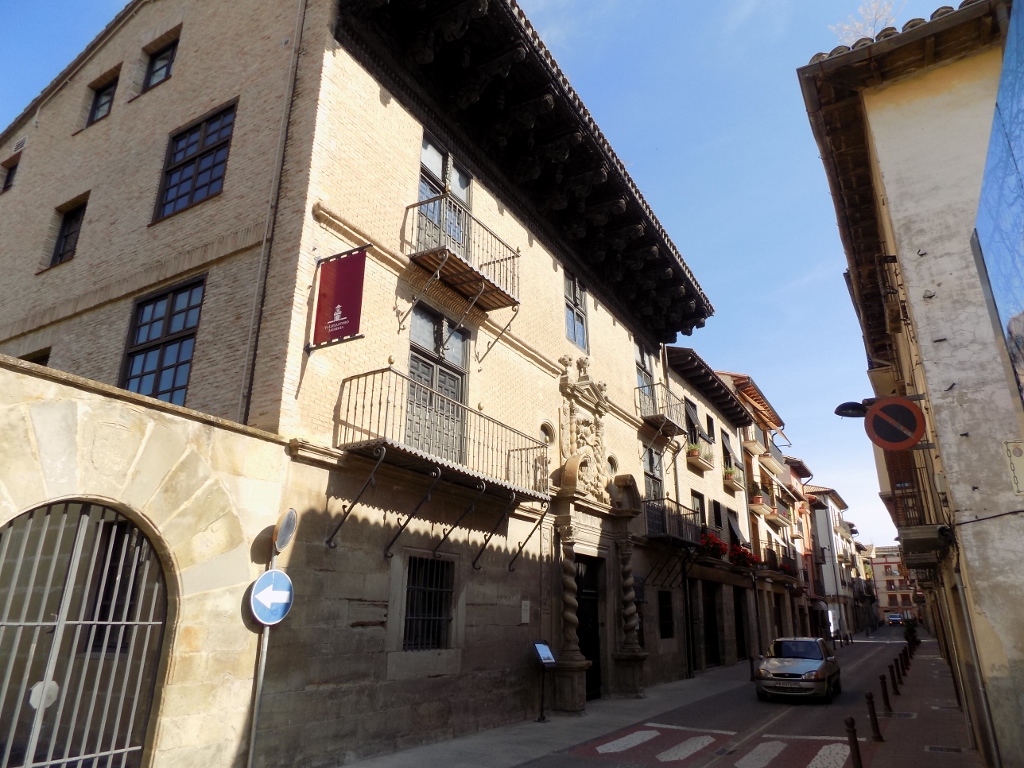 Palace of Ongay-Vallesantoro
Palace of Ongay-Vallesantoro
It was here that I noticed for the first time the impressive wooden eaves which I would later see more often. Concretely, this was on a Baroque building from the 17th century.
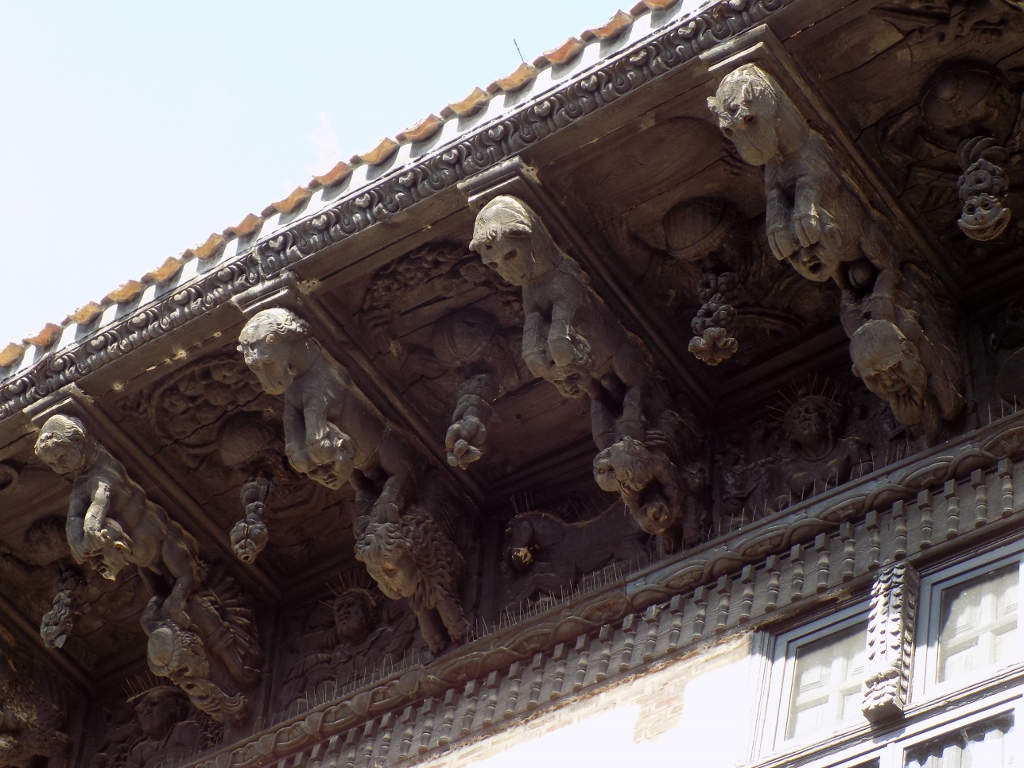 Palace of Ongay-Vallesantoro, a detail
Palace of Ongay-Vallesantoro, a detail
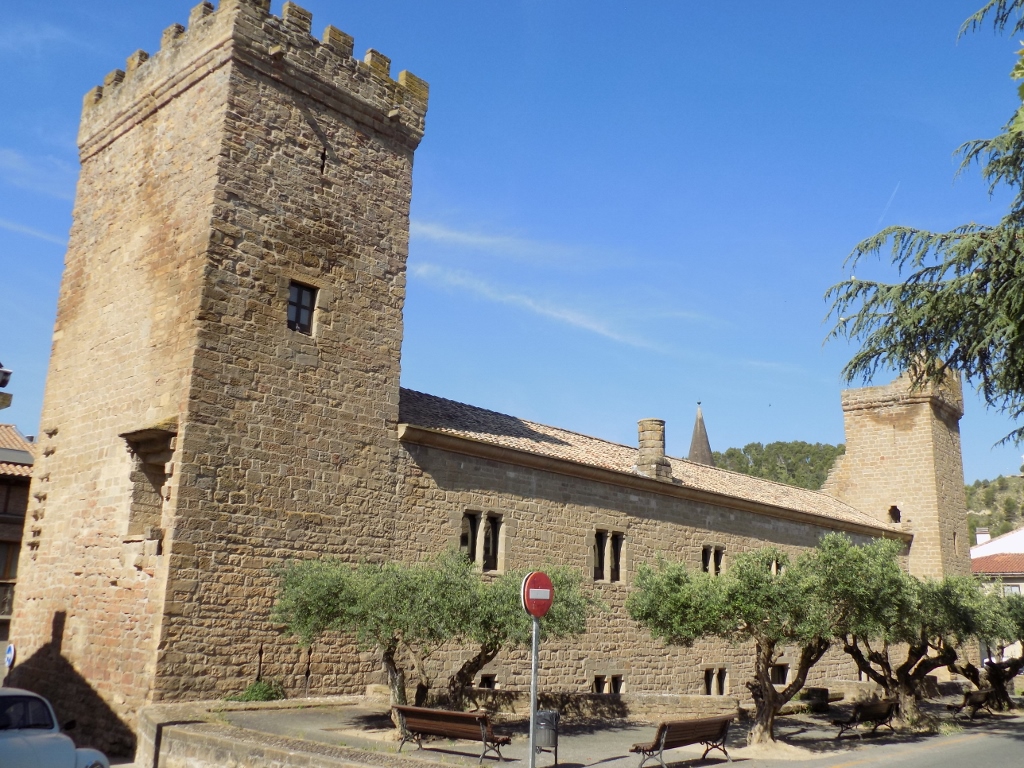 Palace Prince of Viana (one of the titles of the heir to the Spanish crown) which is a home to a library today
Palace Prince of Viana (one of the titles of the heir to the Spanish crown) which is a home to a library today
There are lots of members of the Basque people in Sangüesa so the names of the streets are written on two languages. Thus I learned that “street” is written “karrika” in the Basque language.
It was only at the end of the day (it was Sunday, which means that public transportation is exceptionally rare) that I caught a coach to Monreal where I found my co-pilgrims and soon I wrote a text for the day and posted it form my friends.
Day 7: “A place where they bid you “Good morning!””
This morning I woke up at 5:45 and when I looked around I saw that I was completely alone in the dormitory. That meant that everybody has already left before the sun started to scorch. Still, I heard a couple of voices on the ground floor, so I went down and wished Beli and Angela “Good way!” (“Buen Camino”), and then went back to bed.
And yet, I could not go back to sleep and I only tossed and turned in my bed. This was all very unusual for me. I generally sleep well, so any change in that department is very disturbing. In addition, I also felt some strange dizziness and my head was not very clear which petrified me. Later I realised it could be a consequence of the drugs I was taking against coughing and infection, recommended by the doctor, since I have developed some dry cough in the meantime and asked about it when I went to the doctor’s as an emergency on account of my toe.
As far as the toe is concerned, when I wanted to dress it, it seemed to me it was puffing up again, so just in case I walked over to the Health Care Centre and there I met another shift that was on duty this day. While passing through the streets of Sangüesa on a Sunday morning, everybody I came across bid me good morning and I responded likewise. Since Sangüesa is the place in which they tell you “Good morning!” in the street, I remembered Desmond Morris and concluded that this is the place with a proper measure and size. They even have a bullfight ring!
It turned out, however, that there is a lot of gibberish on the internet and thus the information on how I could get out of here was not true at all and I had to go to the Tourist Information Office in order to get correct information. There I chatted nicely with the girl on duty and helped her find the site that provides false information so that she could react in connection with that.
It also meant that I would stay in Sangüesa until 7 pm! Because of this I decided to do some sightseeing and there was the main church right across the street. I also visited another building, but I did not feel I had enough energy, so I went back to the albergue. There I spent some hours on internet, writing to my friends, but I also helped the kind hostess hang up for drying the already washed laundry. She talks very fast and I can actually understand quite little. When I tell her to slow down and she indeed slows down, I can understand her perfectly. Still, at some point she started telling me about her family and I realised that some younger sister of hers got ill and apparently she even passed away, her father lost his faith and my collocutor started crying at this point while tears poured down her face. I did try to be understanding, although I actually understood very little, but I could not tell her in the middle of her crying: “Ok, now stop and tell me all of this again but slowly so that I can understand you better.”
By the way, that dry cough which I have mentioned first appeared in Jaca, the night before continuing with my Way. This felt quite odd, since I did not feel as if I had cold. Still, I coughed almost the entire night, but during the day it calmed down although I was aware that something strange was happening in my throat. The night in Arrés I started to cough again just before going to sleep and this was probably the reason why I had troubles about this. The same thing happened in Ruesta. When I went to see the doctor in Sangüesa, I asked her what she would recommend. The doctor listened to my lungs, everything was fine, but I found it interesting that she did not seem surprised. She recommended a couple of drugs, so I bought them as well and started taking them. While I was resting in Sangüesa I coughed relatively a lot and then I started to wonder what was happening to me. Blisters, blue nails, cough… Nothing too bad by itself and in the comfort of one’s home, but a huge burden on any journey, especially on the Way where I’m supposed to walk and cover long distances. Some would say I was cleansing myself (in terms of energy) and perhaps they would be right, but I never knew I was so dirty in the first place.
No matter how slowly, the time did pass, so at some point I left the albergue in Sangüesa and went to the stop to catch a bus to Monreal. When I got there, the rest of the group had already been well settled and were about to start with the dinner. They asked me if I would be interested, which I of course was, so soon we were all sitting at the table and with a lot of laughter and talk we ate together.
In front of me: 735 km
Behind me: 132 km
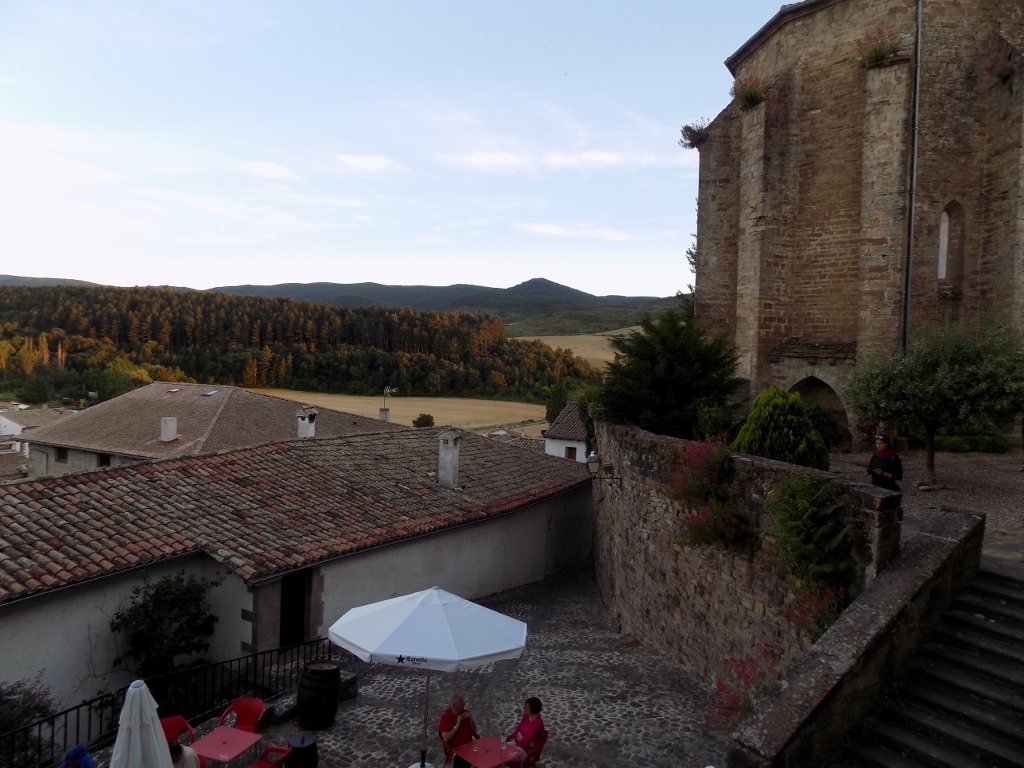 Evening in Monreal
Evening in Monreal